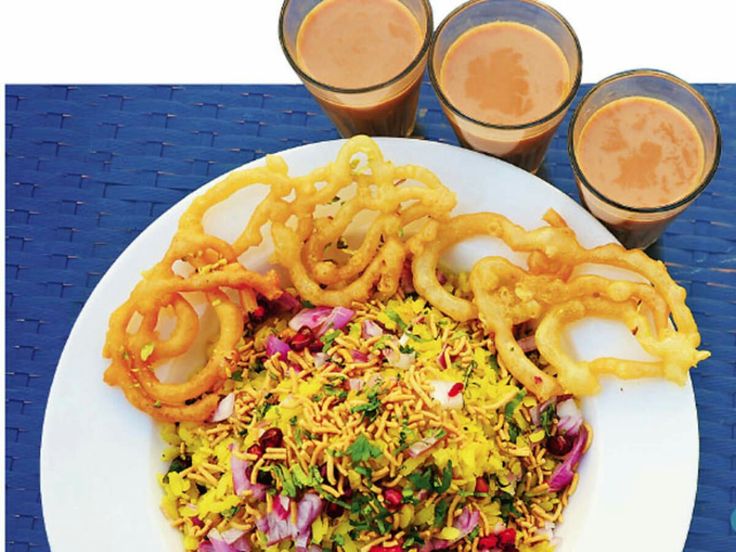Poha Jalebi aur Chai: A Heavenly Trio, Hai Rabba!
Namaste doston! Kem cho? As-salamu alaykum! Chef Curry Do’pyaza here, back with another recipe that’ll make your taste buds sing a Bollywood tune! Today, we’re diving deep into a breakfast staple, a symphony of sweet, savory, and spicy: Poha Jalebi aur Chai!
This isn’t just a meal; it’s an experience, a cultural hug, especially popular in the vibrant streets of Madhya Pradesh, my home! Imagine waking up on a cool morning, the air crisp and clean, and the aroma of these three delicacies wafting through the air. Ah, pure bliss!
When do we devour this delightful combination?
Poha Jalebi isn’t just for breakfast; it’s a celebratory dish! You’ll find it gracing tables during festivals like Diwali and Dussehra. It’s the perfect treat after a long day of kite flying during Makar Sankranti. And let’s not forget those cozy winter mornings when all you crave is something warm and comforting. It’s also a common sight during weddings and other auspicious occasions, symbolizing sweetness and prosperity.
A Little History Lesson
While the exact origins are shrouded in delicious mystery, Poha (flattened rice) has been a staple in Indian cuisine for centuries. Jalebi, with its Persian roots, found its way into the Indian culinary landscape and became a beloved sweet treat. Somewhere along the line, a genius decided to pair the savory Poha with the syrupy Jalebi, creating a match made in food heaven! Add a steaming cup of chai, and you have a breakfast fit for a king (or queen!).
Let’s Get Cooking!
Preparation Time: 15 minutes
Cooking Time: 20 minutes
Ingredients – The Star Cast of Our Dish
- Poha (Flattened Rice): 2 cups, medium thickness
- Pyaz (Onion): 1 medium, finely chopped
- Hara Mirch (Green Chilies): 2-3, finely chopped (adjust to your spice level!)
- Rai (Mustard Seeds): 1 teaspoon
- Jeera (Cumin Seeds): 1 teaspoon
- Haldi (Turmeric Powder): 1/2 teaspoon
- Nimbu ka Ras (Lemon Juice): 1 tablespoon
- Hara Dhaniya (Fresh Coriander): 2 tablespoons, chopped
- Cheeni (Sugar): 1 teaspoon (optional, for a touch of sweetness in the poha)
- Tel (Oil): 2 tablespoons
- Namak (Salt): To taste
- Jalebi: As many as your heart desires!
- Chai: Prepared according to your preference. I like mine strong and milky with a hint of ginger!
Step-by-Step Instructions – Easy Peasy Lemon Squeezy!
- Wash the Poha: Gently rinse the poha under running water for a few seconds. Don’t over-wash it, or it will become mushy. We want it soft but not soggy!
- Soften the Poha: Soak the rinsed poha in a bowl of water for about 5 minutes. This will soften it up beautifully. Drain the water completely using a strainer or colander.
- Tempering Time: Heat oil in a pan or wok over medium heat. Add mustard seeds and let them splutter. Then, add cumin seeds and let them sizzle.
- Add Aromatics: Add chopped onions and green chilies. Sauté until the onions turn a light golden brown.
- Spice It Up: Add turmeric powder and sauté for a few seconds. Be careful not to burn the turmeric.
- Poha Power: Add the softened poha to the pan. Mix well to coat the poha with the spices and oil.
- Seasoning and Flavor: Add salt and sugar (if using). Mix well. Cover the pan and cook for 2-3 minutes, stirring occasionally, until the poha is heated through.
- Lemon Zest: Squeeze lemon juice over the poha and mix gently.
- Garnish and Serve: Garnish with fresh coriander leaves. Serve hot with crispy, syrupy Jalebi and a steaming cup of chai!
Chef Curry’s Top Tips for Poha Perfection!
- Don’t Over-Soak: Over-soaking the poha is a cardinal sin! It will result in a mushy mess.
- Tempering is Key: The tempering (tadka) is where all the flavor magic happens. Don’t skimp on the mustard and cumin seeds!
- Spice it Right: Adjust the amount of green chilies according to your spice preference. Remember, you can always add more, but you can’t take it away!
- Fresh is Best: Use fresh ingredients for the best flavor. Fresh coriander adds a vibrant touch to the dish.
Cooking it Your Way – Adaptable and Awesome!
- Gas Stove: The traditional and most common method. Follow the instructions above.
- Induction Stove: Works just like a gas stove. Adjust the heat settings accordingly.
- Microwave: Not ideal for the entire recipe, but you can reheat leftover poha in the microwave. Cover it with a damp paper towel to prevent it from drying out.
- Air Fryer: I do not recommend making Poha in an air fryer.
- Slow Cooker/Crockpot: Poha is best made fresh and quickly, so slow cooking is not recommended.
Nutritional Information (Approximate per serving)
- Calories: 350-400
- Carbohydrates: 60-70g
- Protein: 5-7g
- Fat: 10-15g
- Fiber: 2-3g
Note: These values are approximate and may vary based on specific ingredients and portion sizes.
Serving Suggestions – Make it a Feast!
- Garnish: Sprinkle some sev (crispy chickpea noodles) on top for added crunch.
- Sides: Serve with a side of dahi (yogurt) or raita for a cooling contrast.
- Drinks: Besides chai, you can also enjoy it with a glass of fresh juice or lassi.
Time to Get Cooking!
So there you have it, folks! My take on the classic Poha Jalebi. I urge you to try this recipe at home. It’s simple, delicious, and guaranteed to bring a smile to your face. Share it with your friends and family, and let them experience the magic of this Indian breakfast delight!
Happy Cooking, and remember, pet pooja, kaam duja! (Food first, work later!)
